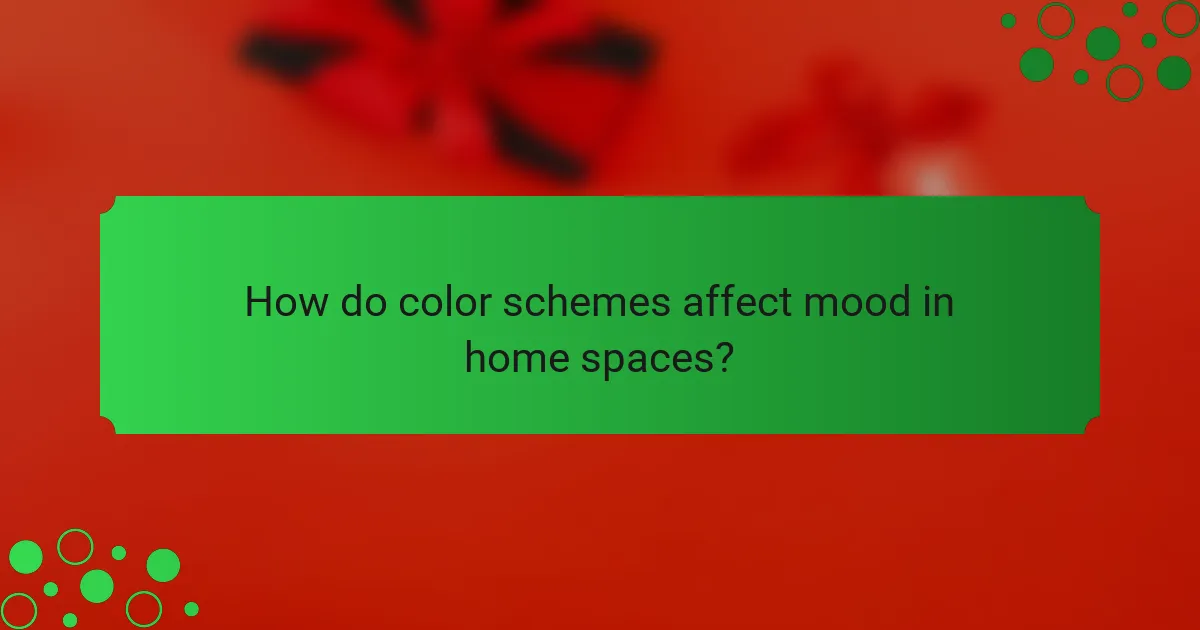Choosing the right color scheme for home renovation is essential for creating a harmonious and inviting atmosphere. By considering factors such as room purpose, natural light, and personal style, you can select colors that not only enhance the aesthetic but also influence mood and perception of space. Popular combinations like gray and yellow or blue and white can transform your living areas, making them both functional and visually appealing.

What are effective home renovation color schemes?
Effective home renovation color schemes involve selecting colors that create a cohesive and appealing aesthetic. These schemes can enhance the atmosphere of a space, influence mood, and even affect perceived size and light within a room.
Neutral color palettes
Neutral color palettes consist of shades like beige, gray, white, and taupe, providing a versatile backdrop for various design styles. They promote a calm and sophisticated environment, making them ideal for living rooms and bedrooms.
When using neutral colors, consider incorporating different textures and materials to add depth. For example, pairing a soft gray wall with a plush cream sofa can create a warm and inviting space.
Bold accent colors
Bold accent colors, such as deep reds, vibrant blues, or bright yellows, can energize a room and draw attention to specific areas. These colors work well when used sparingly, such as on an accent wall or through decorative elements like cushions and artwork.
To effectively use bold colors, choose one or two to highlight while keeping the rest of the palette neutral. This approach prevents overwhelming the space and maintains a balanced look.
Monochromatic schemes
Monochromatic schemes utilize varying shades and tints of a single color, creating a harmonious and cohesive look. This approach can make a room feel more spacious and organized, as it eliminates visual clutter.
When implementing a monochromatic scheme, mix different textures and patterns to add interest. For instance, a light blue room can feature dark blue accents in furniture or decor to create depth without straying from the color family.
Complementary color combinations
Complementary color combinations involve pairing colors that are opposite each other on the color wheel, such as blue and orange or red and green. This contrast can create a vibrant and dynamic atmosphere in a room.
To use complementary colors effectively, balance them by allowing one color to dominate while the other serves as an accent. This strategy helps maintain visual harmony while still achieving a striking effect.
Analogous color schemes
Analogous color schemes consist of colors that are next to each other on the color wheel, such as blue, blue-green, and green. These combinations create a serene and cohesive look, ideal for spaces meant for relaxation.
When designing with analogous colors, choose one dominant color and use the others as accents. This method ensures a smooth transition between colors, enhancing the overall aesthetic without creating discord.

How to choose a color scheme for home renovation?
Choosing a color scheme for home renovation involves understanding the purpose of each room, the natural light available, existing furnishings, and your personal style. A well-thought-out color palette can enhance the overall aesthetic and functionality of your home.
Assessing room function
The function of each room should guide your color choices. For example, calming colors like soft blues or greens work well in bedrooms, while vibrant hues like yellows or oranges can energize spaces like kitchens or playrooms. Consider the mood you want to create in each area.
Make a list of each room’s primary use and the activities that will take place there. This will help you select colors that support those functions effectively.
Considering natural light
Natural light significantly affects how colors appear in a space. Rooms with ample sunlight can handle bolder colors, while darker areas may benefit from lighter shades to create a more open feel. Observe how light changes throughout the day to determine the best color options.
Test paint samples on walls and observe them at different times to see how they interact with the light. This will help you avoid surprises once the renovation is complete.
Evaluating existing furnishings
Your existing furniture and decor should influence your color scheme choices. If you have a statement piece, like a colorful sofa or artwork, consider colors that complement or contrast with it effectively. Neutral tones can provide a backdrop that allows these items to stand out.
Take inventory of your furnishings and their colors. Create a mood board to visualize how potential paint colors will work with your current items.
Understanding personal style
Your personal style is crucial in selecting a color scheme that feels right for you. Whether you prefer modern minimalism, rustic charm, or eclectic designs, your color choices should reflect your tastes. Look for inspiration in magazines, websites, or social media platforms.
Identify a few key colors that resonate with you and consider how they can be combined. Create a cohesive palette by selecting complementary shades and accents that enhance your overall style.

What are popular color combinations for living rooms?
Popular color combinations for living rooms can create distinct atmospheres and enhance the overall aesthetic. Choices like gray and yellow, blue and white, and earth tones with greens are frequently favored for their versatility and appeal.
Gray and yellow
The gray and yellow combination offers a modern and vibrant look. Gray serves as a neutral backdrop, allowing the bright yellow accents to pop, creating a cheerful environment. This pairing works well with various styles, from contemporary to industrial.
When using gray and yellow, consider the balance between the two colors. Too much yellow can overwhelm, while too little may not have the desired effect. A common approach is to use gray for larger surfaces, like walls or furniture, and yellow for smaller accents, such as cushions or artwork.
Blue and white
Blue and white is a classic combination that evokes calmness and serenity. The cool tones of blue paired with the crispness of white create a refreshing and airy feel, making it ideal for living spaces. This scheme is particularly popular in coastal or nautical-themed designs.
To effectively implement this color scheme, consider using various shades of blue, from light sky blues to deep navy, to add depth. White can be used for trim, furniture, or larger decor elements, ensuring the space feels open and inviting.
Earth tones and greens
Earth tones combined with greens create a natural and grounding atmosphere. This palette often includes shades like browns, tans, and muted greens, which can bring the outdoors inside. Such combinations are perfect for creating a cozy, organic vibe in living rooms.
When working with earth tones and greens, aim for a harmonious blend. Use darker earth tones for larger areas, while incorporating lighter greens for accents. This approach can help maintain balance and prevent the space from feeling too heavy.

How do color schemes affect mood in home spaces?
Color schemes significantly influence the mood and atmosphere of home spaces. Different colors can evoke various emotions, impacting how we feel and interact within our environments.
Warm colors for energy
Warm colors, such as reds, oranges, and yellows, are known to create a sense of energy and vibrancy. These hues can stimulate conversation and activity, making them ideal for social spaces like living rooms and kitchens.
When selecting warm colors, consider using them as accents rather than dominant shades to avoid overwhelming the space. For example, a warm orange accent wall can energize a room without making it feel too intense.
Cool colors for calmness
Cool colors, including blues, greens, and purples, promote a sense of calm and relaxation. These shades are perfect for bedrooms and bathrooms, where tranquility is essential for rest and rejuvenation.
To enhance the calming effect, opt for softer, muted versions of these colors. Light blue or soft green can create a serene atmosphere, making it easier to unwind after a long day.
Bright colors for creativity
Bright colors, such as vibrant pinks, yellows, and greens, can stimulate creativity and inspiration. These colors are often used in home offices or creative spaces to encourage innovative thinking and productivity.
Incorporating bright colors can be done through artwork, furniture, or accessories. A bright yellow chair or a colorful rug can add a playful touch without overwhelming the overall design.

What tools can help visualize color schemes?
Several tools can effectively help visualize color schemes for home renovation. These tools range from digital applications to physical samples, allowing homeowners to see how different colors will look in their spaces.
Color Visualization Software
Color visualization software allows users to upload photos of their rooms and experiment with various color palettes. Programs like Sherwin-Williams’ ColorSnap or Benjamin Moore’s Personal Color Viewer provide a realistic preview of how colors will appear on walls. These tools often include features to adjust lighting conditions, helping users make more informed choices.
Paint Sample Boards
Using paint sample boards is a practical way to visualize color schemes in your home. Purchase small sample pots of paint and apply them to poster boards or directly on walls to see how they look at different times of the day. This method allows for a tactile experience, helping you assess texture and finish alongside color.
Mobile Apps
Mobile apps like Houzz or ColorSnap can be convenient for visualizing color schemes on the go. These apps often include features to match colors from photos or suggest complementary shades. They can also provide inspiration from other users’ projects, making it easier to find the right combination for your renovation.
Virtual Reality Tools
Virtual reality (VR) tools are an innovative way to visualize color schemes in a fully immersive environment. Some home improvement stores offer VR experiences that let you walk through a digitally rendered version of your home with different color schemes applied. This technology can provide a unique perspective on how colors interact in a three-dimensional space.
